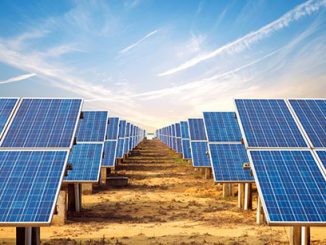
Solar sector has showed great resilience and despite the COVID-19 pandemic, we witnessed another record breaking year with 139 GW installed solar capacity, bringing the global total to an estimated 760 GW, going by estimates from Renewables 2021 Global Status Report. Asia eclipses other regions in terms of installations and accounted for almost 58% of annual capacity addition, with China leading from the front with 48.2 GW of new solar PV capacity. Outside of China, the global PV market grew from 79 GW in 2019, to at least 90 GW in 2020, a 14% increase year on year.
Global manufacturing remained under pressure, largely because of pandemic-related disruptions, lockdowns and labour shortage, supply chain disruptions at polysilicon facilities, shortage of solar glass, shipping bottlenecks. However the global shipments reached 131.7 GW of cell/module, registering a growth of almost 7% over the previous year. China contributed almost 86% of the total shipments and of the top 10 companies, 9 were from China alone. Silicon wafer based PV technology accounted for about 95% of the total production in 2020 and the share of mono crystalline technology is now about 84% (compared to 66% in 2019) of total c Si production. Other trends that were evident were increasing demand for bifacial modules (a difference of only 1-2 $ cents/wp), increasing wafer sizes (to allow power range upwards of 600Wp per module.) and dominance of half cut cells (60 cells/120 half cells to make way for 72 cell/144 half cells).
India remains the fifth largest market for solar PV and has set out an ambitious target of 450 Giga Watt (GW) of installed renewable energy (RE) capacity, including 280GW from solar, by the year 2030. As of now (October 2021), the installed capacity of solar stands at 46.2GW[1] of the 101GW of RE capacity installed. The achievement has witnessed considerable contribution from imports of solar cells and modules over the years. As per the data published by the Ministry of Commerce, Government of India, the country has imported solar cells amounting to INR 4,218.6 Crores3 during the year 2020-21.
Considering the solar capacity installation in the years to come (with a target of 280GW by 2030), it is important for the country to enhance the domestic manufacturing capacity of solar and reduce dependence on imported components. This will contribute to the country’s Gross Domestic Product (GDP), provide opportunities for skill development and employment, make India a global manufacturing hub, provide opportunities for exports, etc. Currently, India has a cell production capacity of about 4GW/year and a module production capacity of about 16GW/year, which is inadequate to meet the future requirement of almost 25 GW solar PV capacity addition annually. Manufacturing in India is hampered due to some issues such as:
- Limited manufacturing capacity and smaller scale of production: The country is estimated to add 25,000MW of solar capacity every year (straight line average) to achieve 280GW by 2030. However, the current manufacturing is limited given the scale required, and hence, witnesses dependence on imported cells and modules. LONGi Solar, a world leader in solar PV manufacturing, reported 58 GW of monocrystalline silicon wafer shipments and PV module shipments of 24.5 GW in 2020, which alone is almost triple of total module production in India.
- Lack of vertical integration: The manufacturing facility in India is limited to solar cells and modules, however, the upstream stages of manufacturing involving polysilicon, ingot and wafer is still absent in the current Indian landscape, on account high production costs and limited technology exposure. Major global producers are fully or largely vertically integrated to capture stable value add.
- Inverted duty structure: It has been analyzed that the applicability of import duty on finished products for solar is lower than the import duty on raw materials related to it. This in turn demotivates the stakeholders engaged in manufacturing, as the landed cost for a component manufactured from raw material could cost more than the imported component.
- Increase in GST: Recently, the Goods and Services Tax (GST) Council has given the recommendations (Notification No. 8/2021-Central Tax (Rate) released on 30.09.2021)[2] to increase GST from 5% to 12% on solar components including on solar panels and inverters which will increase the landed cost of solar components manufactured domestically.
- Increased imports from China: With limited production capacity, Indian developers resort to import of solar panels from China. The applicability of safeguard duty on solar cells and modules has recently expired and the Basic Customs Duty (BCD) will come into effect in April 2022, providing a window of 9 months for projects to import solar components with no additional duties, thereby increasing the import quota and limiting the use of domestic components. Further, there have been quality concerns raised by the stakeholders on the quality of imported components.
- Higher capital and operational costs: Indian manufacturers’ bill of material is about 9-10% higher than that of their Chinese counterparts for non-Domestic Content Requirement (DCR) modules and about 20% higher for DCR modules. Also, a dearth of access to land parcels, proximity to ports, Special Economic Zone (SEZs) and insufficiency in technology leads to higher capital costs adding up to high capital and operational cost.
- Pipeline visibility and slower deployment: Due to lack of demand visibility, investors often find it difficult to plan capacities and execute it. The Government of India targeted 100 GW solar installed capacity by 2022 and indicated annual capacity addition of almost 20 GW per year. However, the deployment remains around half of this target.
In addition, the domestic manufacturing is also susceptible to varying cost of raw materials required for solar manufacturing, such as steel, aluminum, copper, glass, etc. Further, as the geographical location of solar manufacturing units is concentrated in a few states, the cost of transportation is higher to far flung sites that are located in other states.
However, realizing the need for domestic manufacturing which has strong investment potential and associated skill development and employment opportunities, the Government of India has undertaken some steps to promote domestic manufacturing:
- Lower corporate tax rate: The government has introduced a favourable tax regime for new manufacturing companies, slashing corporate tax rate to 15% for new manufacturing units, one of the lowest tax rates for manufacturing units globally.
- Imposition of BCD: Starting April 2022, the import of solar modules and cells will attract BCD of about 40% and 25% respectively to promote the use of domestic modules and cells and reduce the dependence on imported components.
- Mandate on Approved List of Models and Manufacturers (ALMM): The Ministry of New and Renewable Energy (MNRE) has notified a list of ALMM which are manufactured domestically and are eligible for use in government/government assisted projects/projects under government schemes.
- Bureau of Indian Standards (BIS) certification: The BIS has set out standards to be adopted for solar components such as modules, inverters, batteries, etc. Only certified modules are allowed to enter the Indian domestic market. The BIS certificate is valid for two years from the date of issuance.
- Central Public Sector Undertaking (CPSU) scheme: To boost local manufacturing capacity, the government had launched this scheme to set up 12,000 MW of solar capacity by government companies. A recent tranche for 5,000 MW has been tendered out through Indian Renewable Energy Development Agency Ltd. (IREDA) and has been oversubscribed.
- PM-KUSUM scheme and Grid-connected Rooftop Solar Programme Phase-II: In the PM-KUSUM and Grid-connected Rooftop Solar Programme Phase-II, wherein government subsidy is given, it has been mandated to source solar PV cells and modules from domestic sources.
In order to boost domestic manufacturing of solar cells and modules, the Government of India has come up with Performance Linked Incentive (PLI) scheme with a budget outlay of INR 4,500 Crores. The scheme facilitates upstream vertical integration starting from manufacturing of polysilicon to ingots and wafers, solar cells, and modules. The scheme received overwhelming response from the industry with bids received for 54GW of manufacturing capacity. Submission of bids from conglomerates like Reliance, Adani, Larsen & Toubro, Jindal group, apart from existing manufacturers like First solar, Vikram Solar, Tata Power solar, Waaree, Emmvee, Jupiter solar, etc. to set up giga scale facilities illustrates the confidence in the sector.
While the country is promoting domestic manufacturing of solar components, few recommendations as given below would help boost the sector –
- Long term roadmap: There is a need to formulate a roadmap for long term, say next 10 years, around the capacity installations expected every year to ensure the market is ready and has visibility on the annual demand of solar cells and modules.
- Partnership with technology providers: As highlighted above, India’s manufacturing facility at present is limited to cells and modules and the polysilicon and ingot/wafer is still imported. Thus, there is a need wherein technological partnerships can be established to help transfer manufacturing technology to scale local production.
- Module recycling: Once the modules achieve their useful life, the constituents such as the glass, aluminum, semiconductors, lead, cadmium can be recovered for reuse for other applications, thereby reducing requirement of sourcing same metals/components considerably.
- Phased Manufacturing Program (PMP): The Union Budget 2021 announces phased manufacturing plan for solar gear. A PMP will promote domestic manufacturing in the solar sector, its assemblies/sub-assemblies, and parts/sub-parts/inputs of the sub-assemblies thereof. PMP not only aids the development of domestic manufacturing and generate employment opportunities but gives ample visibility to manufacturers to plan their investment for establishment of a robust manufacturing base.
- Incentives for manufacturers: The first round of PLI has received a warm response, however only 4 entities may end up taking the entire capacity on offer. Given the Industry appetite, it is imperative to support further capacities with an additional outlay. After mSIPS sunset in 2018, there has not been a central level incentive to support manufacturing, hence a PLI or another program may be considered to also support smaller manufacturers.
- Attractive export incentive: Export incentives should be raised to promote export quality product manufacturing and enable India to emerge as an export hub in the future.
- Cheaper electricity: Electricity is a key component in manufacturing and variable cost may be reduced by offering subsidised electricity to manufacturers or through relaxations in open access norms. Optimisation efforts could be done through promotion and creation of frameworks which encourage captive usage for solar manufacturers. State regulators should also promulgate a different slab of tariffs (lower than the existing ones) for the industries falling in special manufacturing zones.
- Policy on manufacturing of equipment and machinery used in solar production: While we seek self-reliance in polysilicon/wafer/ingot/cell/module production, the capital equipment remains almost entirely imported. Complete self-sufficiency shall be achieved when the equipment and machine tools are also manufactured in the country.
- R&D between academia and industry: While the solar technology is evolving and higher module sizes and efficiencies are being witnessed, there is a need for a partnership between the industry and academia to setup research and development (R&D) facilities to explore avenues for increased efficiencies and reduced costs. HJT Tandem, Topcon technologies, perovskite, etc. hold a huge potential for the future and India should also be leading the race when it comes to R&D.
With energy transition becoming a key agenda, manufacturing should be viewed differently, especially when a fully integrated eco-system will reduce dependencies on imports, ensure job creation and increase the value retained in India. Systematic approach to scale project pipeline, incentivizing manufacturing ecosystem for the entire value chain and accelerating on-ground infrastructure development shall help achieve the dream of not only ‘Make in India’ but also ‘Make for the World’.
[1] https://cea.nic.in/wp-content/uploads/installed/2021/09/installed_capacity.pdf Accessed on 10 Oct, 2021
[2] https://cbic-gst.gov.in/pdf/central-tax-rate/notfctn-08-2021-cgst-rate.pdf


